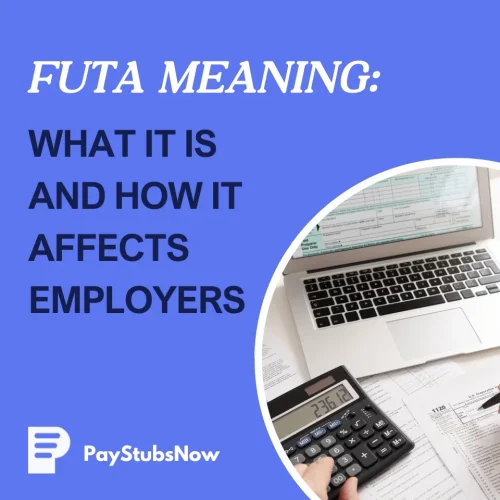


FUTA may sound like just another tax acronym, but ignoring it can cost your business in penalties and missed compliance. Whether you're hiring your first employee or managing a growing team, understanding how the Federal Unemployment Tax Act (FUTA) works is essential.
This guide explains the FUTA meaning, who pays it, how it compares to state unemployment taxes, how to calculate your liability, and when to file.

When people search for FUTA meaning, they're asking about the Federal Unemployment Tax Act: a U.S. law requiring employers to pay tax on employee wages. This money funds unemployment benefits for workers who lose jobs through no fault of their own, helping them stay financially stable while searching for new employment.
FUTA was established in 1939 as part of the U.S. safety net. The tax is collected federally but distributed to states to support their unemployment insurance programs.
Think of FUTA as a financial cushion: during recessions or downturns, eligible workers can receive benefits, which keeps consumer spending steady and the economy more resilient.
| Fast Fact: FUTA only applies to the first $7,000 in wages paid to each employee per year, making it easier to calculate your maximum liability per worker. |
|---|
Staying compliant with FUTA requirements protects your business from IRS penalties and interest. These can add up quickly if you neglect your obligations.
When you pay FUTA tax, you contribute to a system that helps stabilize the economy during downturns. This indirectly benefits your business by maintaining consumer spending power.
| Master Payroll Compliance From the Start Understanding FUTA is just one piece of the payroll puzzle. Learn how to stay compliant with federal and state requirements. Read our Payroll Compliance Guide |
|---|

Employers bear full responsibility for FUTA tax payments. Your employees never see FUTA deductions on their paychecks.
You must pay FUTA if:
These thresholds apply to most standard businesses across the United States.
A standard business becomes liable for FUTA when meeting either the $1,500 quarterly wage threshold or the 20-week employment test.
If you hire a part-time assistant who earns $500 per month, you'll trigger FUTA liability in the first quarter they work for you. Small businesses often don't realize they've crossed this threshold until tax time.
If you hire domestic workers like nannies, housekeepers, or gardeners, you're considered a household employer. The FUTA threshold for household employers is lower: you must pay FUTA if you pay $1,000+ to household employees in any calendar quarter.
Farm owners are subject to FUTA if they:
These higher thresholds recognize the seasonal nature of agricultural work.
Not all employers must pay FUTA tax. Common exemptions include:
| Need to Issue Year-End Tax Forms? Whether you're filing for contractors or employees, accurate W-2s and 1099s make tax season easier. Generate W-2s and 1099s Instantly |
|---|

When researching the FUTA meaning and its application, you'll likely come across SUTA (State Unemployment Tax Act) too. Both fund unemployment benefits, but they differ in administration, rates, and wage bases.
| Tax | Who Pays | Standard Rate | Wage Base |
|---|---|---|---|
| FUTA | Employer only | 6% (0.6% after credits) | First $7,000 per employee |
| SUTA | Usually employer | Varies by state | Ranges $7,000–$50,000+ |
Another major payroll tax is FICA (Federal Insurance Contributions Act), which funds Social Security and Medicare programs. While both FUTA and FICA support the U.S. social safety net, they operate differently:
FUTA helps workers during unemployment, while FICA supports employees during retirement and later life.

As an employer, understanding how to calculate your FUTA tax liability is crucial. Here's a breakdown of the steps involved:
As discussed, FUTA applies only to the first $7,000 of each employee's annual wages.
Taxable wages include:
Excluded from FUTA:
Multiply each employee's taxable wages (up to $7,000) by the 6% rate. This gives you the gross FUTA tax owed before any adjustments.
Here's the formula to calculate the FUTA tax for a single employee:
FUTA Tax per Employee = Total Wages Paid x 6.0% (but capped at $7,000 in wages)
Most employers can reduce their FUTA liability by claiming a credit for state unemployment tax contributions. When applied in full, this credit lowers the effective rate from 6% to 0.6%. You typically claim this credit when you file your state unemployment tax return and receive a SUTA credit certificate. Employers in credit reduction states may qualify for a smaller credit, resulting in a higher net rate.
Once you've determined the FUTA tax for each employee and accounted for the potential SUTA credit, you can calculate your net FUTA tax liability for the tax period.
Here's the formula:
Total FUTA Tax Liability = (FUTA Tax per Employee) - State Unemployment Tax Act (SUTA) Credit (if applicable)
💡 Example: An employee earns $20,000 in 2025. Only the first $7,000 is subject to FUTA.
Keeping clear payroll records ensures these calculations are accurate and audit-ready.
Note: This is a simplified guide. For specific details and potential variations, it's always recommended to consult with a tax professional or refer to the official guidelines for FUTA tax calculations found on the IRS website.
| Stay Organized With Compliant Pay Stubs Track wages and tax thresholds with professional pay stubs. No subscriptions, no complex software required. Generate Pay Stubs Now |
|---|
Once you've calculated your net FUTA liability, the next step is reporting it to the IRS. Employers do this using Form 940, Employer's Annual Federal Unemployment (FUTA) Tax Return.
Understanding the FUTA meaning and staying compliant becomes easier with proper documentation. Paystubsnow helps you create professional paystubs that track wages accurately for tax purposes.
For small businesses without dedicated payroll departments, Paystubsnow offers a simple way to maintain professional records that support tax compliance.
Generate paystubs now and take control of your payroll documentation in just a few clicks.
Remember: Even though professionals use and trust Paystubsnow, we are not a CPA (Certified Public Accountant) firm, law firm, or legal advisory service. Our website helps you easily create paystubs, invoices, W2s, and 1099 forms. We don't provide legal or tax advice. It's always a smart idea to consult with your own CPA, tax advisor, or lawyer to ensure you're complying with all applicable laws and regulations.